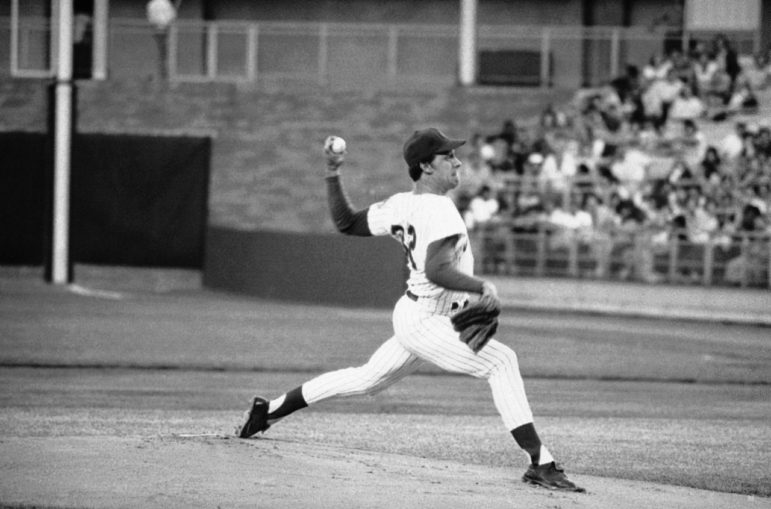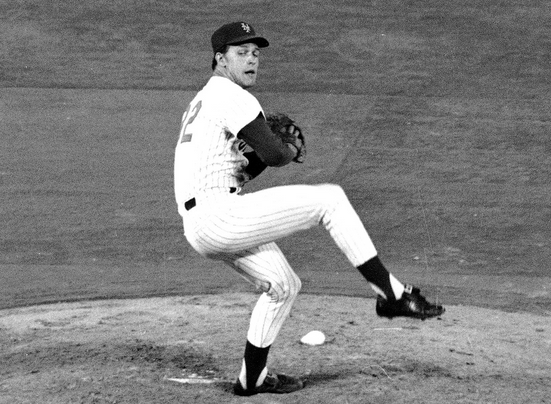Over the coming weeks, we’ll look back at the 50th anniversary of the Mets‘ 1973 National League pennant-winning team by examining the most inspirational figures of that remarkable run. We continue with a young left-handed pitcher who overcame a potentially disastrous injury to be the team’s top performer down the stretch.
On a dreary and drizzly evening in front of a paltry 6,840 at Shea Stadium, Matlack made the seventh start of his second full season. The reigning National League Rookie of the Year would see more than just his career flash before his eyes on May 8. A searing line drive off the bat of Atlanta’s Marty Perez headed back to the mound—resulting in a pitcher’s greatest fear.
With almost no time to react, Matlack did all he could to prevent direct contact. The ball nicked his glove and struck him square on the left side of his forehead. The ricochet actually allowed two Braves runners to score, but that concern was mild compared to the pressing worry about the condition of the 23-year-old pitching star as he writhed on the ground.

Both teams gathered around Matlack before he was placed on a stretcher and hauled away to a local hospital—the final diagnosis: a fractured skull. And in what can only be deemed a baseball miracle, Matlack returned to the same mound 11 days later, wearing a hockey goalie’s headband for protection.
If he appeared timid in the wake of his brush with mortality, it would have been understandable. But Matlack soon shook off any residual fears and regained the form of his rookie year at a very opportune time. On his way to ranking third in the NL in strikeouts with 205, he won six of his final seven regular-season decisions—most coming during a stretch when New York went 24-9 to go from worst to first in the NL East.
Matlack’s hot hand carried over into October, as his smooth delivery and effective mix of pitches held postseason opponents to four runs in 25.2 innings. Game 2 of the NLCS was his finest performance—and one of the best performances in franchise history. It came when the Mets were desperate to regain momentum from the Cincinnati Reds.
New York wasn’t facing a must-win situation by ordinary standards. Still, there was a sense of urgency considering who it was up against—a lineup of Hall of Fame–worthy bats with bold-faced names like Pete Rose, Joe Morgan, Tony Pérez, and Johnny Bench. This was as close as you could get to a 1970s version of “Murderer’s Row.” Limiting its potency was a task not many were able to accomplish. Tom Seaver nearly did it, only to be victimized by solo homers from Rose and Bench in a tough-luck 2–1 defeat in Game 1.
Matlack, though, could deftly negotiate the explosive Reds’ attack and barely permitted them to reach base. Forgoing his usual volume of fastballs, he instead relied on an assortment of breaking pitches to throw Cincinnati’s power bats off-balance. It worked to near perfection. In a 5–0 complete-game victory, the only two hits came from unheralded Andy Kosco. As for the quartet of Rose, Morgan, Pérez, and Bench, they combined to go 0-for-16.

Little changed for the rest of the series. The Reds mustered just six more runs. Game 5’s 7–2 win ended with Matlack in the bullpen—in case Tug McGraw encountered ninth-inning trouble. Rather than an emergency role in the fifth game, he got the coveted starting assignment for the World Series opener in Oakland.
Since this series went seven games, Matlack got three starts—each against the A’s Ken Holtzman. He won just once, but didn’t allow an earned run in two of those outings. Victimized in Game 1 on a grounder under the legs of reliable second baseman Félix Millán, which preceded a 2–1 loss, Matlack came back stronger in Game 4—going eight innings and yielding three hits in a 6–1 New York victory that drew the Mets even.
Matlack was asked to pitch the seventh game on three days’ rest. It was his lone dud of the entire postseason. The costliest missteps came in the third inning. Two-run blasts from Bert Campaneris and eventual series MVP Reggie Jackson knocked out Matlack, and the Mets were staggered to a state from which they wouldn’t recover.
While the Mets never approached the same level of success in the ensuing years, Matlack continued to be a dependable part of the rotation. In fact, 1974 was arguably his best season: a 2.41 ERA, a 149 ERA+, a league-best FIP of 2.42, and seven shutouts.
The Mets didn’t comply. Run support resulted in an undeserved 13-15 record.
Jon Matlack left New York after the 1977 season and, with a career ERA barely over 3.00, remains one of the more underrated Mets ever. Recent induction into the team’s Hall of Fame is evidence of his success.















